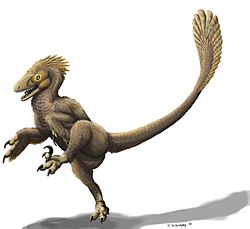Balaur facts for kids
Quick facts for kids BalaurTemporal range:
Upper Cretaceous, 70 mya |
|
|---|---|
 |
|
| Balaur bondoc displaying its double sickle claws in a kicking action |
|
| Scientific classification | |
| Kingdom: | |
| Phylum: | |
| Class: | |
| Superorder: | |
| Order: | |
| Suborder: | |
| Infraorder: | |
| Superfamily: |
Dromaeosauroidae
|
| Family: | |
| Genus: |
Balaur
|

Balaur is a genus of dromaeosaurid theropod dinosaur that lived in southern Europe during the Upper Cretaceous, about 70 million years ago.
The specimen is unique: unlike most other dromaeosaurs, it had two sickle claws on each foot, not just one. It had a reduced and presumably nonfunctional third finger, consisting of only one rudimentary phalanx.
The specimen was discovered in 2010. Balaur lived on a large prehistoric island called Hateg Island. Seventy million years ago, sea levels were much higher than they are today. Europe was an archipelago of islands.
Possibly because it was relatively isolated from other dinosaurs, Balaur developed unique features. It was a small 1.8–2.1 metres (5.9–6.9 ft). This is an example of island dwarfism.
There is one known species, Balaur bondoc. Balaur was a velociraptorine. Studies have shown that it is most closely related to the famous Asian dromaeosaurid Velociraptor.
Images for kids
See also
 In Spanish: Balaur para niños
In Spanish: Balaur para niños


